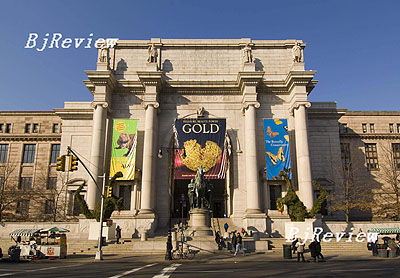
During his first shift on duty as a night security guard at the American Museum of Natural History (AMNH), a newly recruited night-shift watchman was stunned to see the displays come to life and begin to wreak havoc…
Alright, it's just a movie. Hollywood blockbuster, Night at the Museum, opened last December to great box office success. The displays at AMNH do not come to life-perhaps to the great disappointment of young fans--but the movie has given a strong boost to the number of visitors reported by the New York City museum.
The 138-year-old institution normally draws in 4 million visitors each year. After the film Night at the Museum was presented, the museum saw an increase of 60,000 visitors between the Christmas and New Year holiday period (from December 25 to January 5) compared with the same time period a year earlier, said Steve Reichl, Director of Media Relations at AMNH.
Reichl told Beijing Review that while the production team was shooting the movie, the museum launched its own "Night at the Museum" program. The program invites kids and their parents to come and spend a night at AMNH.
"It's a whole different aspect to the museum. They go on flashlight tours to the dinosaur hall," Reichl said, adding that this is a very popular program and tickets are already sold out until the end of the year.
The night stays are only a part of AMNH's many programs focusing on children. The museum has been paying much attention to public education, especially for its youngest visitors.
Educational role
"We have very strong mission in this area [of education]," said Christopher Raxworthy, Associate Dean of Science for Education and Exhibitions at AMNH.
Raxworthy said there are many levels of education AMNH is engaged in. At the local level, the museum integrates itself with public schools in New York, providing training to schoolteachers and inviting school groups to visit the museum.
Every year, the museum is visited by more than 400,000 children in school groups, many of them participating in formal education programs, according to statistics provided by AMNH. Groups are guided through the museum's halls by instructors and guides who teach classes, lead hands-on activities and help students learn about such topics as the environment, the age of dinosaurs, the universe and world culture.
Beyond the local level, AMNH also works on the national level. The museum is in a partnership with a major publisher of science textbooks, and provides content for students from grade one through grade six, Raxworthy said. In fact, he said, the education provided to students by AMNH spans from kindergarten programs to PhD and post-doctoral programs.
Children are the "young explorers," Raxworthy said. They come to the museum at age three or four and are given a basic understanding of science. The goal is to get them interested and excited about science with hands-on experiences. A good first impression means many of these children will return often throughout their lives.
"Those young children actually start with us before they start with regular school," said Raxworthy.
For high-school students, the museum offers free after-school courses to complement and build upon what high-school students learn in the classroom. In addition, 35 high-school students are selected each year to conduct long-term research projects with AMNH scientists.
Those educational programs help increase scientific understanding among both adults and children, according to museum marketers, and deepen the public comprehension of issues that affect the future of the planet and its inhabitants and provide a forum for exploring the world's cultural diversity.
The museum has a serious side to its studies as well. The Richard Gilder Graduate School was launched by the museum last October, and has been approved for a PhD program in comparative biology.
The school will start to accept applications this fall and start classes next fall, said Raxworthy. It marks the first time that an American museum has been given the authority to award its own PhD degree.
| 